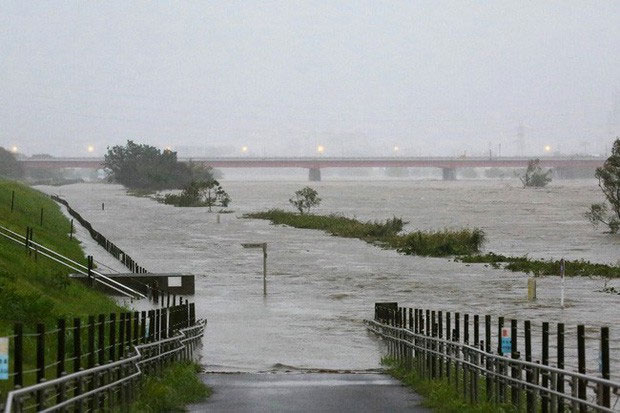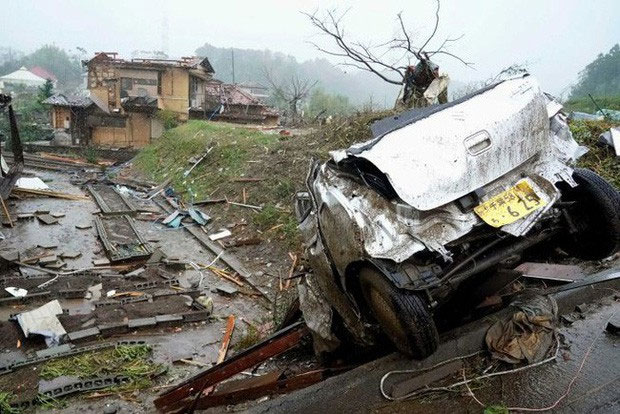Japan: The country suffers from many natural disasters and the way to protect people makes the whole world admired
As a country constantly suffering from natural disasters from earthquakes, tsunamis to storms from the Pacific Ocean, the Japanese are always in a position ready to cope with the intensity of natural disasters.
Japanese people are well prepared to withstand the super typhoon Hagibis with record rain

Super Typhoon Hagibis and record rain flooded rivers and dikes.
Super typhoon Hagibis just hit Japan on Saturday night (October 12), causing a record downpour that flooded rivers and dikes causing nearly 4 million Japanese people to be evacuated. Typhoon Hagibis - the largest typhoon in Japan in the last 60 years, devastated many areas of the country on the morning of October 12. After only a few hours, heavy rains inundated the river causing several landslides. A magnitude 5.7 earthquake rocked Chiba prefecture, east of Tokyo, causing a stir among people.

The terrible tornado in Chiba was caused by Typhoon Hagibis.
As a country often faced with natural disasters, Japan is always in a position to carefully prepare to respond to natural disasters to minimize casualties. They know what the "rage" of nature is, so they constantly promote people's sense of coping with natural disasters, as well as educating children about their survival instincts to enter life.
Super typhoon Hagibis has set the record for the largest ever rain and created an extremely dangerous water level, potentially swept an entire city. In preparation for the typhoon, the Japanese meteorological agency has been constantly updating the news and giving rare warnings over the past decades about heavy rainfall in areas that will be affected by Super storm.

The Hagibis super sack caused terrible flooding in Japan.
The Japanese government has mobilized relevant functional forces such as the media to keep on reporting as well as coordinating with other agencies to call residents to evacuate or move to higher floors in nearby solid buildings. Most to avoid the dangers happening.
Immediately after anticipating the dangers of Typhoon Hagibis, the Japanese government canceled hundreds of domestic and international flights of All Nippon Airways. Airport or rail service as well as bullet train service between Tokyo and Osaka are also ordered to suspend service to avoid storms.
With the devastation of the super typhoon, rugby World Cup organizers canceled two matches in Japan for the first time. Tourist attractions in Tokyo including Disneyland and Disneysea theme parks, Ueno Zoo and hundreds of supermarkets, department stores in the city and other surrounding districts are closed. of super typhoon Hagibis.

Scary images of super storm Hagibis.
Last week, when the Japanese meteorological agency predicted that Hagibis' access at one time would endanger the lives of millions, the government quickly evacuated millions of people living below the waterline. sea east of Tokyo.
It can be said that Hagibis was certified by experts that it could compete with the storm of Kanogawa in 1958, killing more than 1,200 people in Shizuoka Prefecture and Tokyo area. To prevent that from happening again, the Japanese government and people have raised their spirits to cope with natural disasters.
Not only floods, Japan has suffered huge earthquakes that can kill 10,000 people and destroy 300,000 houses.
Every day, at about 5 pm, a soothing melody of the Yuyake Koyake children's song is played throughout the Tokyo area from speakers in supermarkets, schools and parks in this 37 million metropolitan megacity.

Terrible earthquake in Tokyo in 1923.
In fact, this is a test of a system designed to save Tokyo people from the horrific natural disasters in human history recorded: the most populous city earthquake on Earth. .
The last major earthquake to hit Tokyo was in 1923. Experts estimate the next earthquake will take place in the next century with an estimated 70% chance that a strong 7-magnitude earthquake will hit Tokyo. before 2050. An estimated 7.3 magnitude earthquake north of Tokyo Bay could kill 9,700 people and injure nearly 150,000 people.

Babies participate in disaster drills.
Recalling the magnitude 7.9 earthquake The Great Kanto Earthquake occurred below Oshima Island, about 100km south of central Tokyo, at noon on September 1, 1923, thousands of buildings collapsed, fire. outbreaks and people escaping to describe the aftermath as a living hell. Official estimates of death and casualties are 105,000 people across Tokyo and nearby cities, although some reports say the true number is much more.
Since 1923, Tokyo has come a long way in preparing for major and minor earthquakes. High-tech skyscrapers are designed to rock, parks have emergency toilets, and benches turn into stoves. A city with the world's largest fire brigade, specially trained to prevent spreading fires after an earthquake.

Elementary students are educated about what to do when an earthquake hits.
Robin Takashi Lewis, a Tokyo expert on disaster preparedness and response, said: 'In the event of a major earthquake, there will be significant damage to important infrastructure such as electricity and gas. " The Tokyo government says it aims to restore electricity within a week, supply water for one month and gas within two months. However, the case of supplies depleted in the city. Large streets like Tokyo and rescue forces are still overloaded.
Households in Tokyo are encouraged to fix furniture to the wall by using L-shaped brackets, place mattresses under cabinets and slip-resistant pads for chairs and table legs. In addition, people in Tokyo are also advised to keep more canned food, bottled water, as well as emergency kits with flashlights, radios and medicines daily. Stores that sell emergency toilet bags can attach to standard toilets when water is cut off.
If millions of people are traveling on the rail and subway network at the time of the earthquake, don't be too scared. Tokyo Metro said its infrastructure was seized and the trains will stop immediately in a state of strong shaking.
Create your own worst-case scenario and accept reality in the face.
Because Japanese people are so used to natural disasters, schools and companies often hold emergency drills on September 1 each year, the anniversary of the 1923 earthquake, now known as Day. Natural disaster prevention . In addition, the Tokyo government published a 339-page book, outlining the various disaster scenarios and how to minimize risks.

Tokyo X Day manga.
This book is distributed to 7 million households in many languages, besides it includes a short comic series called Tokyo 'X' Day and the story ends with the words: This is not a sentence. fantasy story. In the near future, this story will surely become a reality.
Currently, the Tokyo government in particular and the Japanese government in general are working hard to improve the infrastructure, establishing a network of main roads for fire trucks and rescue vehicles. The city has selected 3,000 cases, community centers and facilities as evacuation centers in the event of a major disaster. In addition, there are more than 1200 centers for people who need special care.

A guide for what to do when a disaster strikes.
Faced with the prospect of 5.2 million people trapped in a major earthquake, the Tokyo government wants to avoid mass evacuation and advises people to stay at work or school. Accordingly, businesses and schools will store drinking water, food and other necessities enough to use for at least 3 days for everyone.
Learning from past disasters, Tokyo is adopting modern seismic standards for the majority of buildings. They will bend and shake to prevent collapse, minimize damage in the event of a disaster. Although very well prepared, there are many challenges ahead.
No matter what, it's hard to imagine true chaos. When Day X will finally come, the consciousness and instinct for survival of the people of Tokyo in particular or the Japanese in general will rise strongly to save their city and country.
- 10 most catastrophic disasters in the Philippines
- The most optimistic country in the world is in Asia
- Obsessed the world's most terrible volcanic disasters
- 2012: Many natural disasters, no disasters
- Weather and us
- Guava breeding techniques
- How to provide first aid when gas suffers
- Australia: use neon lights to protect the environment
- The worst natural disasters in 2015
- Interesting surprises in the richest and most relaxed country in the world
- Little known things about the most flat country in the world
- Looking back at the 10 worst natural disasters in American history
 Is the magnetic North Pole shift dangerous to humanity?
Is the magnetic North Pole shift dangerous to humanity? Washington legalizes the recycling of human bodies into fertilizer
Washington legalizes the recycling of human bodies into fertilizer Lightning stone - the mysterious guest
Lightning stone - the mysterious guest Stunned by the mysterious sunset, strange appearance
Stunned by the mysterious sunset, strange appearance